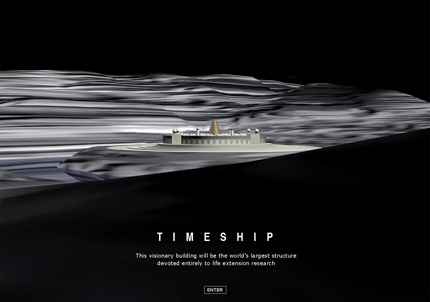
Home page for Timeship's website
Excerpt from The Immortalist (currently, Long Life), a publication of the Cryonics Institute, July 2003
CRYOGENIC STORAGE SEMINAR
On June 14th of this year, a Cryogenic Storage Seminar was held at the Marriott Hotel in Ontario, California. The seminar dealt with research that has been conducted on Timeship (www.timeship.org), a visionary structure designed by architect Stephen Valentine for long-term cryopreservation, and life extension research. The building is planned to hold over 10,000 human patients. A site for the building has not as yet been chosen. Among those attending were Jack Nixon, a CI board member, Tim Freeman, a member of the Cryonics Institute, Alcor, and the American Cryonics Society, and Kelly Moy, an ACS Governor.
Jack Nixon’s impression:
The Timeship Project is very worthy and will provide a much sharper image for Cryonics in the future for those who would prefer a more futuristic architecturally desirable edifice while awaiting reanimation. Many family members would prefer to visit a place like Timeship to remember us, their loved ones, while we are sleeping, awaiting restoration.
Timeship presents a very positive aspect to Cryonic storage, and will bring many new converts to our cause. Timeship is much more for those that are living as well [as] for those that will live again. The Reanimation Research Center will be the most important aspect of Timeship other than its patient storage facilities. However, protection of the patients is paramount. That is its most primary function. It will truly be a timeship for patient protection and to take patients to the future.
Tim Freeman’s impression:
The seminar had several parts: First there was the talk by Valentine about Timeship. He seems to have a good handle on how to make it stable against a lot of different threats. For instance, he takes into account floods, earthquakes, hurricanes, and lots of other environmental threats in site selection.
He has specific plans to keep trucks at a distance so a truck full of explosives can't affect the stored patients, and a separate circle of separation for cars, with suitably weak bridges to ensure that the truck that tries to park with the cars winds up in the moat.
However, I think he's wrongheaded in the psychology required to make it safe. He wants to make it look interesting and to have deep symbolic significance. I believe the patients would be safer if it was as drab and uninteresting as possible, and marketing was entirely divorced from patient storage. He thinks that storing frozen endangered species would decrease the risk from Earth First! types and that storing frozen religious leaders would decrease the risk from religious lunatics, but I think these would increase the risk, especially in the case of religions where a frozen religious leader is not properly buried. I find talk about symbolism to be particularly distressing because there's no way to evaluate the quality of the discourse; any garbage can be spoken and cannot be disproved.
Then there was a talk by Brian Wowk about how to do intermediate temperature patient storage. I think he's onto something important here. The idea is that you store the patient inside a metal can that conducts heat well, and you put the metal can inside an insulating container.
This combination effectively keeps the volume of the inside of the metal can at a uniform temperature. In the inside bottom of the metal can you put a small electric heating coil and a thermocouple. Connect a commercially available controller to the thermocouple and heating coil so it will heat the can as needed to keep the temperature high enough.
Do anything you like to the outside of the insulating container to keep its average temperature below the desired patient temperature. This arrangement makes it possible to keep each patient at a different temperature. The commercially available controllers even have a web server and Internet connection built into them, so you can control your patients' temperatures though an attractive UI from the comfort of your own office.
This is the first life-and-death network security problem I've come across.
Brian had a prototype on hand that was built from a commercially available water cooler. It was big enough to store a head. 21st Century Medicine can sell copies of these prototype units for $2000 each available immediately and versions that are engineered for long-term reliability for $2000 available 60 days from the time they are ordered.
There was further discussion of exactly how stable and efficient various configurations of this idea would be. The presentation was by a consultant cryogenic engineer. I can't recall his name right now.
Last, there was talk by Valentine again about designs for systems like this that are built from scratch. He thinks he can make one container that's good for transport, storage, and cool down. It would have the heat-conductor-in-insulator design mentioned above, with a damped-spring suspension as part of the case [which] would make it possibly survivable if dropped a few feet. Unfortunately nobody has quantitative figures concerning the durability of vitrified brains, so the most important design constraint for the damped-spring suspension is unknown. This would seem to be a solvable problem: vitrify a dog's head, subject it to a known high acceleration, then look for shattering.
And last but not least, Kelly’s impression:
The seminar opened with the proposed future cryonics facility and lab by Stephen Valentine. Set on 350 acres with a 2 football-field diameter circular fortress bound by four balls and a cone in the center. Inside there would be 9 squares that house patients and labs.
Oddly there was such a need on behalf of the architect and others to keep the location secret that a land deal fell through due to leaks to the press while there is such an emphasis on the symbolism and bold outdoor architecture. It was my understanding that storage tanks would measure 75'x75' — scary for the people working there! In each tank patients are suspended vertically in pods, in groups of four, to form a lattice arrangement 75'x75'. Patients are accessed above from a platform through panels while wearing breathing gear and safety ropes. The cost of building phase I was estimated at $7–10 mil.
Change Observer editors’ note: Timeship: The Architecture of Immortality, by Stephen Valentine, was recently published by Images Publishing Group Pty. Ltd.

